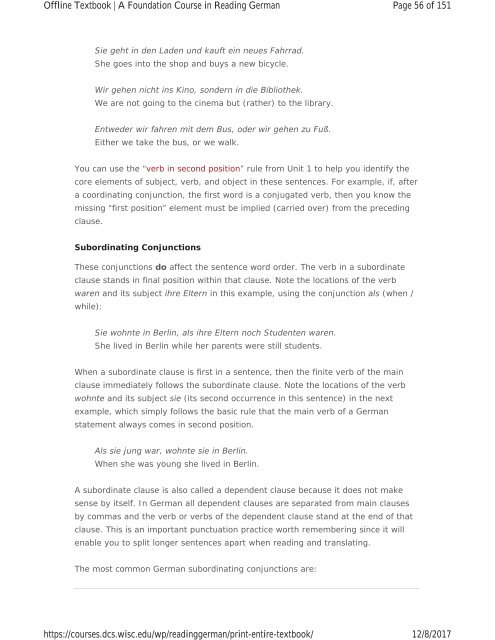A Foundation Course in Reading German, 2017a
A Foundation Course in Reading German, 2017a
A Foundation Course in Reading German, 2017a
Create successful ePaper yourself
Turn your PDF publications into a flip-book with our unique Google optimized e-Paper software.
Offl<strong>in</strong>e Textbook | A <strong>Foundation</strong> <strong>Course</strong> <strong>in</strong> Read<strong>in</strong>g <strong>German</strong><br />
https://courses.dcs.wisc.edu/wp/read<strong>in</strong>ggerman/pr<strong>in</strong>t-entire-textbook/<br />
Page 56 of 151<br />
12/8/2017<br />
Sie geht <strong>in</strong> den Laden und kauft e<strong>in</strong> neues Fahrrad.<br />
She goes <strong>in</strong>to the shop and buys a new bicycle.<br />
Wir gehen nicht <strong>in</strong>s K<strong>in</strong>o, sondern <strong>in</strong> die Bibliothek.<br />
We are not go<strong>in</strong>g to the c<strong>in</strong>ema but (rather) to the library.<br />
Entweder wir fahren mit dem Bus, oder wir gehen zu Fuß.<br />
Either we take the bus, or we walk.<br />
You can use the “verb <strong>in</strong> second position” rule from Unit 1 to help you identify the<br />
core elements of subject, verb, and object <strong>in</strong> these sentences. For example, if, after<br />
a coord<strong>in</strong>at<strong>in</strong>g conjunction, the first word is a conjugated verb, then you know the<br />
miss<strong>in</strong>g “first position” element must be implied (carried over) from the preced<strong>in</strong>g<br />
clause.<br />
Subord<strong>in</strong>at<strong>in</strong>g Conjunctions<br />
These conjunctions do affect the sentence word order. The verb <strong>in</strong> a subord<strong>in</strong>ate<br />
clause stands <strong>in</strong> f<strong>in</strong>al position with<strong>in</strong> that clause. Note the locations of the verb<br />
waren and its subject ihre Eltern <strong>in</strong> this example, us<strong>in</strong>g the conjunction als (when /<br />
while):<br />
Sie wohnte <strong>in</strong> Berl<strong>in</strong>, als ihre Eltern noch Studenten waren.<br />
She lived <strong>in</strong> Berl<strong>in</strong> while her parents were still students.<br />
When a subord<strong>in</strong>ate clause is first <strong>in</strong> a sentence, then the f<strong>in</strong>ite verb of the ma<strong>in</strong><br />
clause immediately follows the subord<strong>in</strong>ate clause. Note the locations of the verb<br />
wohnte and its subject sie (its second occurrence <strong>in</strong> this sentence) <strong>in</strong> the next<br />
example, which simply follows the basic rule that the ma<strong>in</strong> verb of a <strong>German</strong><br />
statement always comes <strong>in</strong> second position.<br />
Als sie jung war, wohnte sie <strong>in</strong> Berl<strong>in</strong>.<br />
When she was young she lived <strong>in</strong> Berl<strong>in</strong>.<br />
A subord<strong>in</strong>ate clause is also called a dependent clause because it does not make<br />
sense by itself. In <strong>German</strong> all dependent clauses are separated from ma<strong>in</strong> clauses<br />
by commas and the verb or verbs of the dependent clause stand at the end of that<br />
clause. This is an important punctuation practice worth remember<strong>in</strong>g s<strong>in</strong>ce it will<br />
enable you to split longer sentences apart when read<strong>in</strong>g and translat<strong>in</strong>g.<br />
The most common <strong>German</strong> subord<strong>in</strong>at<strong>in</strong>g conjunctions are:


















